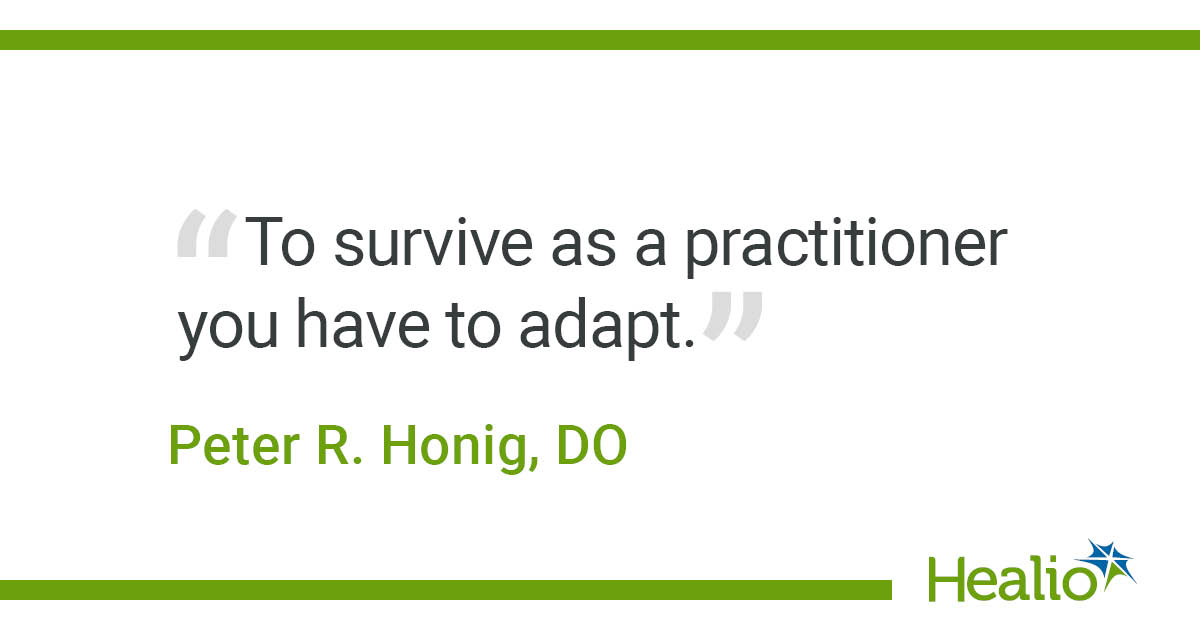Guest Commentary: Managing a private practice during the COVID-19 pandemic

In this Guest Commentary, Peter R. Honig, DO, a family physician with a private practice in Philadelphia, spoke with Healio Primary Care about the strategies he is using to manage his practice during the COVID-19 pandemic.
Three weeks ago, I was driving back from vacation in Canada with my wife, who is also a medical provider. We talked about how we were going to handle this crisis. When you are driving for 12 hours, you have plenty of time to plan. Although telemedicine was not well established and insurance companies were not yet reimbursing for it, using telemedicine was the only way I could imagine continuing to practice in the office. I was sure the insurance companies were going to figure it out, so we immediately started using it. Two days later, CMS announced that it would cover telemedicine services. Since then, insurance companies have voiced that they are going to reimburse for it, as well. This is all because of the CMS announcement. If Medicare hadn’t stepped up to the plate, other insurance companies were not going to either.
CMS’ announcement is a big break for private physicians. My practice started using telemedicine 3 years ago, but we stopped because we weren't getting reimbursed, and the only company that was producing it was charging a lot of money. So, we actually lost money using telemedicine.
Some of the private doctors who I know are still not using telemedicine. They told me that every day there are fewer and fewer visits because patients are afraid to come into the office. I am trying to coach these doctors on how to use telemedicine because it is not hard — people are just afraid of change. But to survive as a practitioner you have to adapt.
CMS said we do not have to follow standard HIPPA rules. I have been using my own iPhone (Apple Inc) and a HIPPA-compliant platform called “doxy.me.” All electronic medical record systems — including “eClinicalWorks,” which is the one we use in our practice, as well as “Epic,” which is the one I use when I see patients in the hospital — have this platform. With doxy.me, I can send my patients a text message with a link that will take them to my virtual waiting room. Some patients have trouble with it, so we have to drop the video portion of the televisit, but probably nine out of 10 patients are able to use it.

Staffing
You don’t need a lot of staff. If you have an office where everybody works close together and a good office manager, it works. We usually have two providers in the office at any given time. One or two people are answering phones and putting patients on the schedule. Providers can handle the rest because it is not like we are taking vital signs for telemedicine visits.
One of our medical assistants is unable to come into the office because she has children but no child care, so she is applying for unemployment. She is in a tough spot because she still wants to work, and she is really good at what she does. Still, we are not desperate for her to be in our office right now. We are paying her while she applies for unemployment.
I hear people talking about not being able to afford some of their employees. We are going to open a line of credit for the practice just so that I can afford to pay everybody in case there is a problem financially down the road. I don't want to lose the talented staff that I have, so I'm willing to make a financial sacrifice to keep everything afloat for some time.
I’m also a palliative care doctor. I'm the only one doing palliative care consults right now at Jefferson Hospital in Philadelphia. I am also working for a hospice and in rehabs and nursing homes. All of this provides additional income.
Self-care
I am sleeping the same number of hours. Most of the conversations we have at home are related to COVID-19. I live with my wife and two younger children. My older son is from Manhattan, New York, but he is currently living at my house because he cannot go back to the city right now. I also have a daughter who lives and is remaining in New York. We speak with her via FaceTime (Apple Inc) every day.
Since day 1, everybody has been recommending “social distancing.” If you ask me, the wording is wrong. It should be “physical distancing,” because you want to still be able to socialize and call that family member you haven't seen in a long time. Everybody is at home. Nobody is in a rush. There are no sports. There are a lot of rerun movies that can be started anytime. Now is a good time to catch up on reaching out to people.
I’m doing a lot of spring cleaning with my wife and sons, as well. I'm still exercising every day because I have equipment at home. I feel bad for people who don’t have that and cannot go to the gym, but luckily the weather is starting to change. During every televisit, I urge my patients to go outside and exercise or go for a walk.
People always ask me when is this all going to end. I don't want to be discouraging — but I also don't want to give false hope — so I tell them to get used to it for now. We are going to have to hunker down. I also give patients the option to reach back out to me if they have nobody else to talk to. Giving people a sense of security is important because this could take a couple more months.
Disclosure: Honig reports no relevant financial disclosures.

